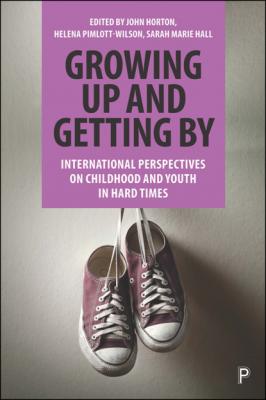Growing Up and Getting By. Группа авторов
Читать онлайн.| Название | Growing Up and Getting By |
|---|---|
| Автор произведения | Группа авторов |
| Жанр | География |
| Серия | |
| Издательство | География |
| Год выпуска | 0 |
| isbn | 9781447352945 |
Many of the following chapters also explicitly deal with children, young people and families living in situations of austerity. As Hall (2019a: 2) notes, ‘austerity’ has a twofold meaning being both a popular term denoting frugality or ‘a condition of severe simplicity and self-restraint’ and, latterly, a descriptor for ‘a specific set of actions and policies by the state: the reduction of spending on public expenditure with the precise aim of reducing governmental budget deficit’. In particular, through this book, austerity is widely used to characterise a repertoire of ideological and policy responses to the 2007–08 global financial crisis and the recessions it later prompted. In this context, many state and federal governments in Europe and North America were quick to adopt severe public sector austerity programmes (see Hall et al 2020). This austerity politics was typified by very substantial and rapid cuts to budgets for welfare, local government, social care, civic spaces, public transport, and cultural, community, educational, heritage and leisure services. Although ideologically justified as a ‘necessary’ process of ‘balancing the books’ and reducing government indebtedness by cutting spend on ‘non-essential’ services, there is now considerable evidence that this vast roll-back of public spending has extended and compounded economic crises and constituted new social-political crises in diverse settings. In the UK, for example, the right-wing Conservative-led government’s HM Treasury Spending Review of 2010 instituted an unprecedented programme to cut public spending in England by £81bn by 2015, including a 51% cut in the budget of national government departments, a £7bn cut in national welfare budget, and a 27% cut in the budget for Local Authorities, while devolving responsibility for implementation of these cuts to local agencies and actors (HM Treasury, 2010). The consequences of this round of multimillion spending cuts are still, at this time of writing, emerging. As with the 2007–08 global financial crisis, academic research primarily figured and theorised austerity as a political-economic event via important concepts, like ‘austerity urbanism’ (Peck, 2012), which foreground the impacts of ‘rolling back’ public expenditure for cities, regions, economic systems and governance thereof (Aalbers, 2009; Kitson et al, 2011). It is only relatively recently that sustained scholarly research has begun to evidence the substantial impacts of austerity for lived and local experiences (O’Hara, 2014), charting the increased prevalence of forms of food poverty (Garthwaite, 2016a), child poverty (Ridge, 2013), social isolation (Cross, 2013; Power and Bartlett, 2019), community breakdown (Jones et al, 2015), social care crises (Loopstra et al, 2016), and populist exclusionary ideologies (Vasilopoulou et al, 2014). Against this backdrop, this book collates new evidence about the haunting impacts of austerity for children, young people and families in diverse contexts. It is our hope that the following chapters will help to open up new kinds of research and conversations about austerity, beyond the political-economic, recognising the profound personal, everyday and intersectional harms constituted by recent austerity politics. Note, again, that we pluralise austerities to acknowledge diverse instances of austerity – past, present and future – and to recognise people’s diverse orientations towards, and experiences of, public funding cuts in practice.
Underpinning all of the following chapters is a concern with longer-run processes of neoliberalism. This contested label critiques a series of linked, decades-long processes through which logics of individualism, free marketeering, cost-effectiveness, competitiveness, self-governance, managerialist reform, and rationalisation have come to be normatively embedded in all manner of workplace, organisational and policy contexts (Newman, 2013; Peck and Tickell, 2002). It is argued that, through these shifts, tactics of organisational ‘leanness’, ‘flexibility’, budgetary efficiency, competitiveness, outsourcing,
